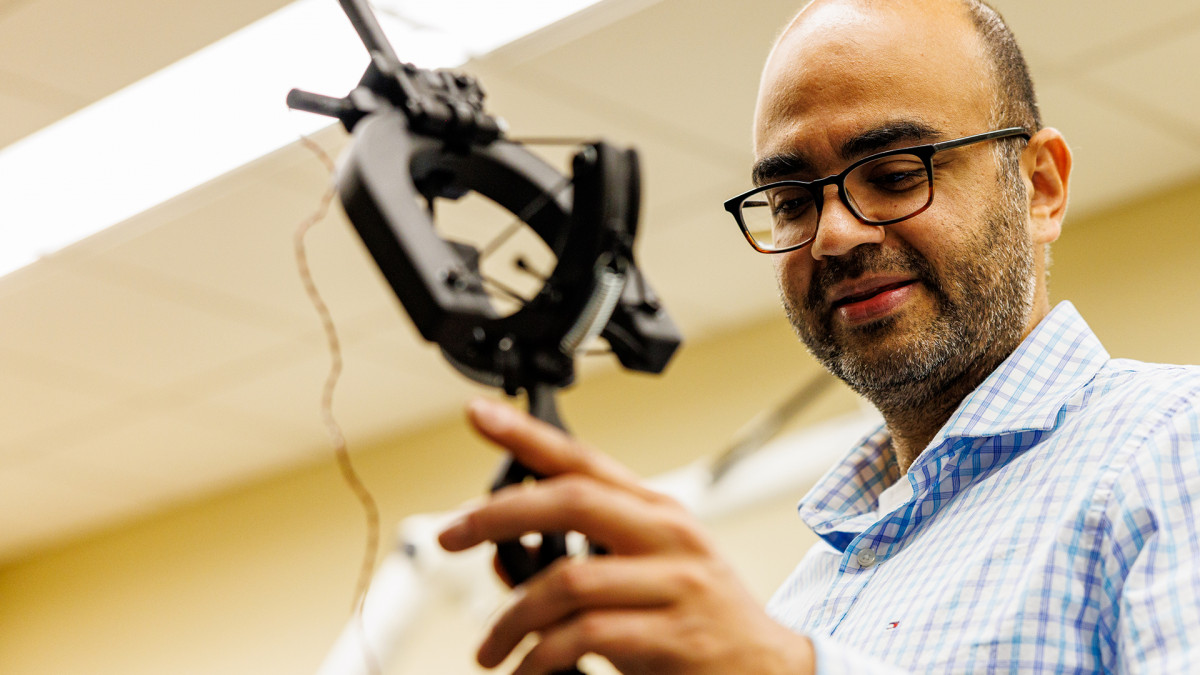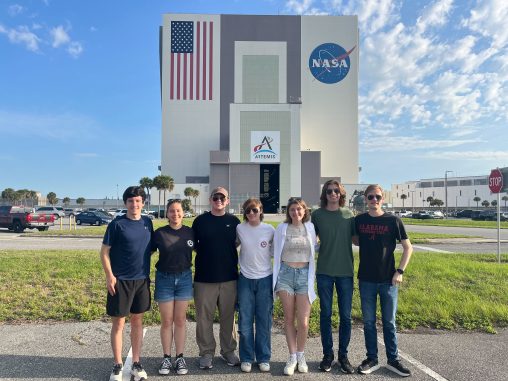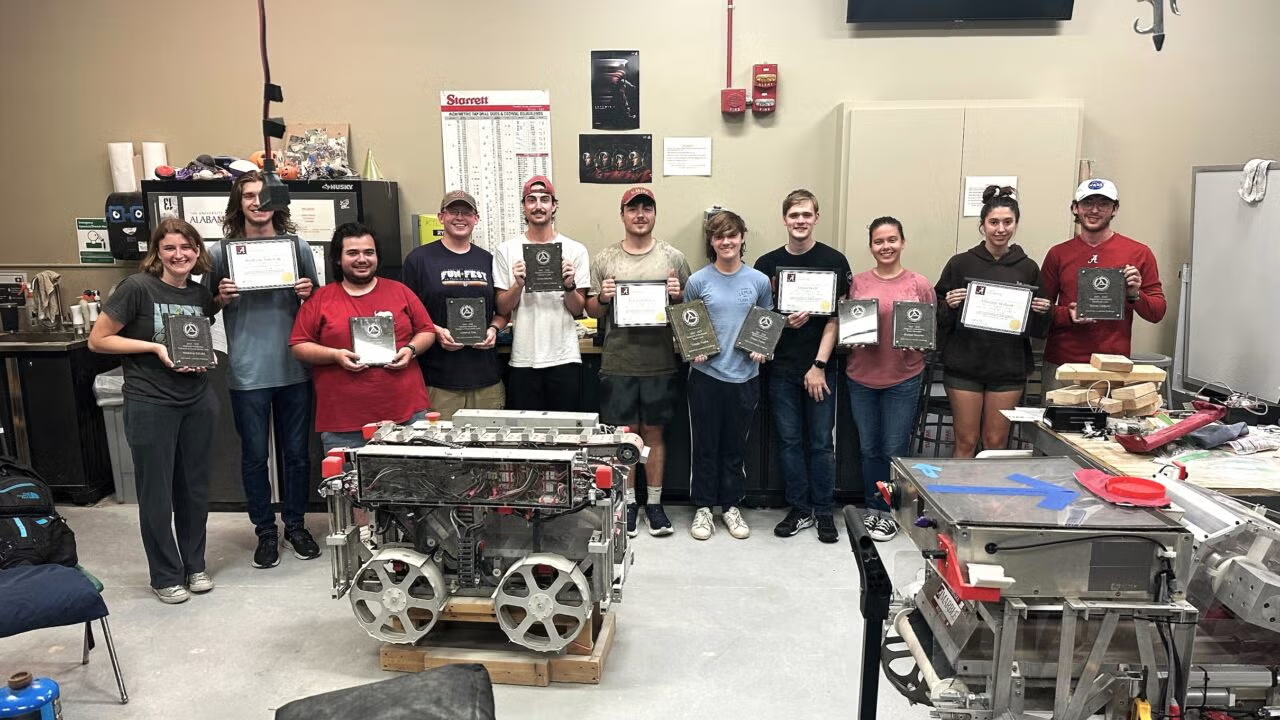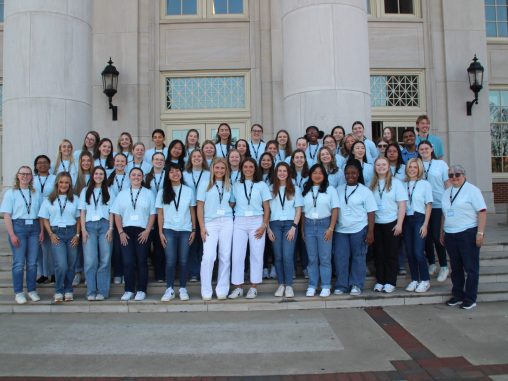



The College of Engineering is making a substantial impact in the areas of engineering education and research. Here is a glimpse at notable data points for the College.
students currently enrolled
research centers
million in new
research awards
student organizations
and competition teams
students employed or
enrolled in graduate school


LunaRecycle, a NASA Centennial Challenge, launched in September 2024 to crowdsource solutions for recycling non-metabolic materials on space exploration missions. The competition focuses on the design, development and demonstration of...

The Alabama Astrobotics Team recently returned from NASA’s 2025 Lunabotics Challenge with national recognition for its innovative approach to lunar robotics and systems engineering. Hosted annually at NASA’s Kennedy Space...

With less than a week before the final event of the 2025 NASA Lunabotics Challenge, members of The University of Alabama Astrobotics team were working in shifts to fine-tune their...

In a recently awarded project, the Alabama Materials Institute at The University of Alabama will aid the Air Force Research Laboratory in developing technology related to a new satellite propellant. The $6 million ASCENT propellant project will see the University working with federal laboratories and industry partners to fully develop this new technology.

University of Alabama students Zachary Griffith, of Pittsburgh, and Jesse Park, of Burr Ridge, Illinois, were selected for the National Oceanic and Atmospheric Administration Ernest F. Hollings Undergraduate Scholarship.

The University of Alabama’s student chapter of the American Institute of Chemical Engineers earned notable honors at the Southern Regional AIChE Conference in Tampa, Florida. The conference brings together chemical...

UA Safe State participated in the H2OSHA outreach campaign hosted by the U.S. Department of Labor and the Occupational Safety and Health Administration’s Birmingham Regional Office for Heat Awareness Week...

TUSCALOOSA, Ala. — The Society of Women Engineers at The University of Alabama recently hosted its largest annual youth outreach event, WOW! That’s Engineering!, welcoming more than 140 third- through...

Jonathan Clayton, a third-year doctoral student studying environmental engineering at The University of Alabama, was selected as a 2024-2025 Fulbright scholar, which is one of the most prestigious academic exchange...

The Alabama Astrobotics Team recently returned from NASA’s 2025 Lunabotics Challenge with national recognition for its innovative approach to lunar robotics and systems engineering. Hosted annually at NASA’s Kennedy Space...

With less than a week before the final event of the 2025 NASA Lunabotics Challenge, members of The University of Alabama Astrobotics team were working in shifts to fine-tune their...

The Alabama Astrobotics Team recently returned from NASA’s 2025 Lunabotics Challenge with national recognition for its innovative approach to lunar robotics and systems engineering. Hosted annually at NASA’s Kennedy Space...

With less than a week before the final event of the 2025 NASA Lunabotics Challenge, members of The University of Alabama Astrobotics team were working in shifts to fine-tune their...

May is National Inventors’ Month. To celebrate, we took a moment to applaud innovation at The University of Alabama, which is designated one of the Top 100 U.S. Universities in 2024 by...

In a recently awarded project, the Alabama Materials Institute at The University of Alabama will aid the Air Force Research Laboratory in developing technology related to a new satellite propellant. The $6 million ASCENT propellant project will see the University working with federal laboratories and industry partners to fully develop this new technology.

University of Alabama students Zachary Griffith, of Pittsburgh, and Jesse Park, of Burr Ridge, Illinois, were selected for the National Oceanic and Atmospheric Administration Ernest F. Hollings Undergraduate Scholarship.

The Alabama Astrobotics Team recently returned from NASA’s 2025 Lunabotics Challenge with national recognition for its innovative approach to lunar robotics and systems engineering. Hosted annually at NASA’s Kennedy Space...

In a recently awarded project, the Alabama Materials Institute at The University of Alabama will aid the Air Force Research Laboratory in developing technology related to a new satellite propellant. The $6 million ASCENT propellant project will see the University working with federal laboratories and industry partners to fully develop this new technology.

The Alabama Space Grant Consortium has awarded four undergraduate scholarships and two graduate fellowships to students in The University of Alabama College of Engineering. The four undergraduate recipients are Rianna...

In a recently awarded project, the Alabama Materials Institute at The University of Alabama will aid the Air Force Research Laboratory in developing technology related to a new satellite propellant. The $6 million ASCENT propellant project will see the University working with federal laboratories and industry partners to fully develop this new technology.

Jonathan Clayton, a third-year doctoral student studying environmental engineering at The University of Alabama, was selected as a 2024-2025 Fulbright scholar, which is one of the most prestigious academic exchange...

May is National Inventors’ Month. To celebrate, we took a moment to applaud innovation at The University of Alabama, which is designated one of the Top 100 U.S. Universities in 2024 by...
Engineering features a wide variety of nationally-accredited programs, affording students the flexibility to shape their academic goals to suit developing interests.
Engineering Undergraduates
Engineering Graduates
National Merit Finalists
Honors College Students
on Merit-Based Scholarships


From students to faculty and staff members, we are committed to recruiting top-tier talent to join the College of Engineering community. Visit the links below to learn more about available academic and job opportunities.
Undergraduate Admissions Graduate Admissions Faculty Positions Open Research Areas Hiring